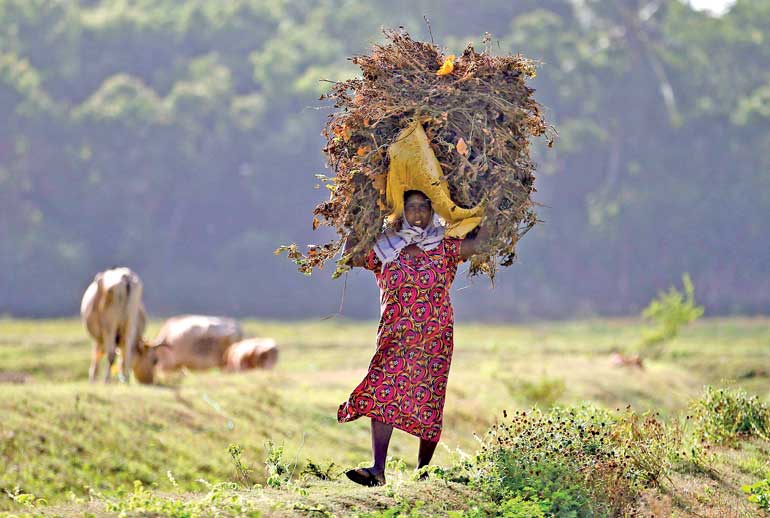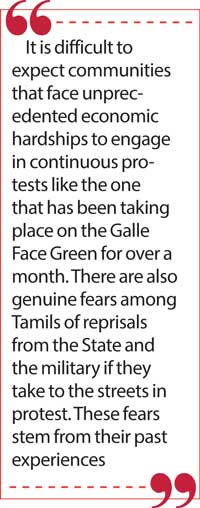Monday Dec 22, 2025
Monday Dec 22, 2025
Tuesday, 10 May 2022 03:35 - - {{hitsCtrl.values.hits}}

 For the past few weeks, many in the south have been asking us why the current crisis has not led to widespread protests in the north. Some ask this question with an implied message that the North should protest; but they fail to question the violence and surveillance that those in the North faced when they protested in the past and their own silence about the repression inflicted on the minorities by the State. There is a sense of privilege that envelops this question. It does not factor in how ethnic and class-based privileges enable some protestors to channel their resistance openly without being harmed, while making others vulnerable to repression.
For the past few weeks, many in the south have been asking us why the current crisis has not led to widespread protests in the north. Some ask this question with an implied message that the North should protest; but they fail to question the violence and surveillance that those in the North faced when they protested in the past and their own silence about the repression inflicted on the minorities by the State. There is a sense of privilege that envelops this question. It does not factor in how ethnic and class-based privileges enable some protestors to channel their resistance openly without being harmed, while making others vulnerable to repression.
There are multiple reasons why the north is relatively quiet these days. But this calmness should not be construed as a sign of the crisis not affecting the northern populations. Farmers, fishing communities, daily-wage earners, war-affected communities, Muslim returnees faced with livelihood challenges, Panchamar caste communities that have faced historical marginalisation and small business men and women are among those in the north who have been hit badly by price hikes and shortages of essential goods. Yet, why haven’t these communities taken to the street in large numbers?
The protest scene in the north: A quick historical glimpse
In order to unpack this calmness, one has to look at the protest culture of the north historically. A good starting point may be the anti-colonialism of the Youth Congress of Jaffna in the early decades of the 20th century. The Congress was guided by an inclusive, progressive vision for post-colonial Ceylon emphasising linguistic equality and elimination of casteism and discrimination against women. However, it made a rather hasty decision to boycott the first elections of the State Council held under the Donoughmore Constitution demanding the full independence of Ceylon. 
The boycott decision made by a group of radical English-educated members of the Jaffna Tamil middle class was later critiqued by many as a missed opportunity and a form of counter-productive disengagement, as it contributed to the North’s isolation in the State Council and this progressive movement’s eventual political demise. Today, this boycott and its consequences are presented as a cautionary tale by some when Tamil actors make grandstanding calls for disengagement with the democratic initiatives and resistance that take place in the south.
In the 1950s, the north saw protests demanding linguistic equality and regional autonomy following the introduction of the Sinhala-only Act. Tamil nationalism emerged as a rallying cry during this period and has since then remained a powerful mobilising force. However, elitism was a hallmark of the Tamil nationalist politics of this era as the Federal Party did not actively strive for social justice for the oppressed caste communities and failed to offer a thoroughgoing critique of the capitalist economic path some of the southern regimes pursued.
However, there were other important developments that merit our attention here. Significant among the protests that took place in the north in the 1960s for a non-elitist cause are the temple entry struggles and the protests for equal treatment in tea shops. These protests faced Police brutality. The Tamil political leadership did not wholeheartedly back these protests.
With the increased Sinhalisation of the State and the further rise of Tamil nationalism, many of these struggles for social equality took a back seat. During Tamil militancy, the LTTE dominated the protest culture in the north. Organised almost exclusively by groups affiliated with the LTTE, protests during this period mainly exposed State oppression of Tamils and demanded autonomy for Tamils in the north-east. Even though the LTTE took some measures to eliminate caste-based discrimination, there was hardly any space free of the LTTE’s influence available for socially marginalised communities to chart their resistance in their own terms. Its impact is still felt in the absence of mass-based social movements and powerful trade unions that can challenge class and caste-based oppression in the north.
Post-war years
In the post-war years, there have been continuous protests in the north demanding justice for the disappeared and the release of the political prisoners and land held by the military. The Ezhuka Thamil rally of 2016 and the P2P of 2021 are two protests organised by Tamil political parties and civil society groups that drew a large number of participants. The organisers of these rallies generally prioritise political questions over economic issues or frame economic problems facing the north primarily, if not solely, as consequences of Sinhala majoritarianism without taking into consideration the historical fissures within the Tamil community along class and caste lines and the class character of the State.
These protests and rallies, which included many just demands, helped advance the Tamil nationalist project. Their ethno-nationalist vision of self-determination, however, excluded the Muslims who live in the north-east. They did not pose a serious challenge to the class and caste-based privileges of the Tamil elite. However, they had the strong backing of the Tamil media in general.
Communities in the north focused on non-nationalist causes too during the post-war period. There were spontaneous protests when a schoolgirl was raped and murdered in 2015. There were large scale protests by indebted communities, especially women, against predatory microfinance companies. In Puttur, Panchamar communities protested against the attempts to revive a cremation ground in their neighbourhood. The New Democratic Marxist Leninist Party and affiliated groups organised some key protests focusing on social, economic and environmental issues that affect the north.
Their protests around caste issues did not win the support of the Tamil political elite. The Tamil media even attacked the protestors derisively. There were also protests by Tamil fishermen against poaching by Indian trawlers. The Tamil political leadership, which was reluctant to back these protests as they might lead to an erosion in the support extended by the people of Tamil Nadu to the Tamil cause in Sri Lanka, later supported them.
The class factor and majoritarianism
In the north, ethnicity, Tamil nationalist politics and the interests and perspectives of the Tamil middle and professional classes play a major role in shaping the protest culture. What protests are organised and encouraged by civil society groups, what protests get the support and attention of the Tamil media and what demands are foregrounded and amplified by the intellectual class are determined by these factors. A powerful white-collar professional class comprising doctors, lawyers and university academics, and priests and clergy of the Hindu and Christian faiths and a few trade union actors with affiliations to Tamil nationalist political parties and the Tamil nationalist media shape the protest scene in the north and mobilise people for protests.
Their focus is primarily on the Sinhala-Buddhist character of the State. They frame the Tamils’ relationship to the State narrowly through an ethnic lens, overlooking the ways in which Tamils relate to the State and are alienated from it in class and gendered terms. They refrain from foregrounding how the class character of the State sometimes affects the minority communities and the Sinhalese through common processes of marginalisation and dispossession; nor do they show much interest in building movements along lines of class that cut across ethnic boundaries.
Today, a section of the Tamil political leaders, some members of the professional class whom the current economic crisis has not hit as badly as Tamils from other social classes, and their media allies are promoting the view that Tamils are not interested in the ongoing economic crisis and that they do not find it necessary to engage in protests because they survived worse economic crises during the war. They are doing so without any economic analysis or serious engagement or dialogue with communities on the peripheries whose income has now become barely sufficient to meet the needs of their families. Uninformed at best and irresponsible at worst, their views are skewed by their status as the privileged lot in the north.
It is this longstanding Tamil nationalist protest culture which places ethnicity over other identities and questions like class and caste that make even some from the communities on the margins who are severely hit by the rise in prices think that they do not need to protest. This protest culture has thrived in a context of Sinhala majoritarianism that affect the economic lives of those on the margins of the Tamil community like the fishing communities in Nayaru whose livelihoods came under threat when powerful fishing companies from the south with the backing of the military and the State invaded the fishing scene in Nayaru.
When this majoritarianism was not challenged vigorously by the south barring a few actors and groups, peripheral communities in the north faced further isolation politically and economically and lost interest in collaborating with protests that took place in the south. While the people’s decision to not engage in protests should not be scorned and their agency to sit out these protests needs to be recognised, one should unpack the larger context in which they are making this decision, the ideologies and class interests of the key players who drive it and how Sinhala majoritarianism animates them.
The northern response
This is only one segment of the political reality observed in the north today. Encouragingly, there are other voices within the Tamil community including those affiliated with Tamil nationalism that persuade the Tamils to engage with the protestors in the south and extend their support and solidarity even if they do not want to join the protests themselves. Some question the limits to these protests in a spirit of engagement and remind the southern protestors about their silence and complicity when the north suffered economically and politically due to majoritarianism. 
Some have shown interest in organising protests in the north in their own terms combining their longstanding political demands with the demands around the economic crisis or in a manner that does not isolate their political aspirations from their immediate economic concerns. There are also voices within the Tamil community that actively challenge the elite’s attempts to foreground the economic resilience of the Tamils during the war as a way of discouraging protests.
One member of the University of Jaffna Teachers’ Association who lived through the civil war in the 1990s observed at a recent meeting that while this resilience should be remembered, it should not be used to normalise the impact of the current economic crisis on Tamils or dissuade them from protesting against the State. Such voices bring in the much-needed analytical nuance to our conversations about the current political moment; point to ways in which the current wave of protests in the south can be made more inclusive; and show genuine interest in exploring the role Tamils can play in such efforts.
The students, teachers and non-academic staff of the University of Jaffna, the Marxist Leninist Party and a youth group affiliated with the TNA, a local group in Manthai, Mannar are among those who organised protests recently in the north. Some of these protests gave prominence to the longstanding demands of the people in the north including demilitarisation, justice for war crimes, political solution along federal lines and the repeal of the Prevention of Terrorism Act in addition to demands such as economic justice for those on the peripheries, introduction of wealth tax, re-distribution of land, returning the wealth stolen by the rulers to the people and safeguarding the free public education and public healthcare systems.
The hartal on Friday also got the support of the traders in the north. These conversations and protests disrupt the narrative that the north does not show much interest in the current economic crisis. They underline the ways in which the north presents its own response to the crisis drawing from its historical experiences as a zone heavily militarised, a region that suffered majoritarian violence, and as a society with its own internal contradictions and hierarchies.
Due to the shortage of fuel and price rise, many affected communities in the rural north, like their counterparts in the south, do not have the economic wherewithal or time to participate in protests or public meetings that take place in towns. When meetings are organised at the village level, the turn-out from members of the local community may increase as evidenced at a recent meeting held in Pandateruppu, Jaffna attended by representatives from farmers’ associations, pre-school teachers, the cooperative sector, youth associations and women’s groups in significant numbers.
It is difficult to expect communities that face unprecedented economic hardships to engage in continuous protests like the one that has been taking place on the Galle Face Green for over a month. There are also genuine fears among Tamils of reprisals from the State and the military if they take to the streets in protest. These fears stem from their past experiences.
Instead of expecting the Tamils to protest against the economic failures of the State or prescribing what demands they should prioritise now, the south should embrace and amplify the just demands that protestors from the north have brought to the forefront over the decades including during the post-war years and most recently during the current economic crisis. The protestors, trade unions, student groups, and civil society groups in the south should examine their complicity in majoritarianism and actively campaign for the safety of the protestors in the north.
In doing so, they will be able to strengthen those voices within the Tamil community that challenge forces that thrive by promoting ethnic polarisation and their narrow class-based interests and perspectives. It may also lead to greater cooperation between the north and south in challenging the state in the future.
(The writer is a Senior Lecturer attached to the University of Jaffna.)